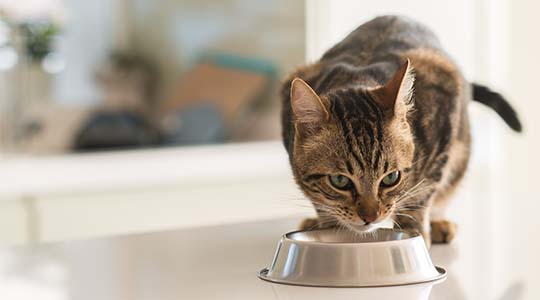

Why should cat food have sodium in it? Sodium content in cat food has an important nutritional and dietary function, just like it does in your food! But it’s important to understand just what it does and how much of it is healthy. That way you can make the best possible decisions about what to feed your cat.
Sodium is an essential mineral for life. Inside the body it is found in the blood and in the fluid that surrounds cells. Sodium itself helps ensure proper nerve and muscle cell functions, maintains a healthy cellular environment and prevents cells from swelling or dehydrating. The sodium levels in IAMS™ cat foods are balanced with other minerals, vitamins, fats, proteins and carbohydrates. That way you can be sure your cat is getting enough for their health.
Meat, poultry, fish and eggs are all good natural sources of sodium, and are the primary ingredients in all IAMS™ cat foods including IAMS™ PROACTIVE HEALTH™ Healthy Adult.
Sodium may also be included in commercial cat foods in the form of ordinary table salt. Salt is an important ingredient in making food more palatable for animals, as well as for people.
The Association of American Feed Control Officials recommends that dry cat foods contain at least a minimum of 0.2%1 sodium — 0.2% of dry matter your cat eats, or 0.5 grams per 1,000 kcal — for maintenance and to support normal growth and development. While higher sodium intake may cause increased thirst, water consumption and urination, excess sodium is passed in the urine.
A veterinarian may recommend changing your cat’s sodium intake to help decrease high blood pressure, eliminate excessive body fluid or as a precaution if kidney, liver or heart heath is a concern. You can keep track of your cat’s overall wellbeing at home if you regularly check their C.A.T.S. — Coat, Appetite, Temperament and Size — for any changes that might lead to questions for the vet.
Healthy cats of all ages don’t normally require a low- or reduced-sodium diet, so be sure to talk to your vet about any sodium concerns you may have before making a change.
Cats’ bodies work differently from our own, and learning to care for them is a process! What your cat eats impacts everything from their energy levels to their mood to the health of their skin and coat. By understanding what healthy cats and kittens need from their food, like sodium, antioxidants, fiber and more, you’re better able to give your cat a diet that helps them thrive.


Fiber isn’t just for humans — it’s an important part of balanced nutrition for cats, too!
But how much fiber do cats need, what kinds should they be eating and how can you make sure they’re getting the right amount for their bodies?
Cats and humans both need fiber in their diets, but that doesn’t mean cats should be eating the same amount as humans. People are growing more aware of the importance of fiber in our own diets today — and while it’s good to think about your cat’s fiber intake too, it’s important to remember that cats have different dietary needs than humans.
Cats have a much shorter digestive tract than humans, and unlike humans, cats are carnivorous, so their nutritional needs are better satisfied with mostly animal-based ingredients rather than plant matter.
Nondigestible fiber supports cat health by providing bulk that helps move food through the digestive system. This fiber is largely made up of carbohydrates that cats can’t break down in the same way they digest protein or fat. This undigested matter helps usher food through your cat’s system at a healthy pace that lets them absorb the nutrients in their food and eliminate waste comfortably. Higher levels of nondigestible fiber can even help address specific conditions like frequent hairballs.
Fiber can’t be broken down and digested like proteins and fats, but some kinds can be fermented (broken down by bacteria) in your cat’s digestive system. This breakdown produces short-chain fatty acids, which provide energy to your cat’s intestines as it is fermented.
Fiber sources used in pet foods include cellulose, which is poorly fermentable; beet pulp, which is moderately fermentable; and gums and pectin, which can be highly fermentable. Appropriate levels of moderately fermentable fiber, such as beet pulp, provide the benefits of energy for the intestinal lining and bulk without the negative effects of excessive stool or gas. That makes them ideal for the health and comfort of most cats!
While a high-fiber diet can be part of a weight-loss solution for humans, our research has found that it’s not as helpful as a weight-reduction option for cats.
High levels of poorly fermentable fiber in cat food dilute the calories and nutrients in a serving and may make your cat feel fuller. Unfortunately, high fiber content can also increase the rate at which food passes through your cat’s digestive tract, making it harder for them to digest other nutrients in their food. They may be going to the litter box more often, but that doesn’t mean their digestive system is working more efficiently.
When choosing a pet food, remember that cats and humans need different things from their food. All IAMS™ cat food products are made with the right amount of moderately fermentable fiber needed to promote intestinal health. Use the IAMS™ Cat Food Selector to find a recipe tailored to your cat’s unique needs.